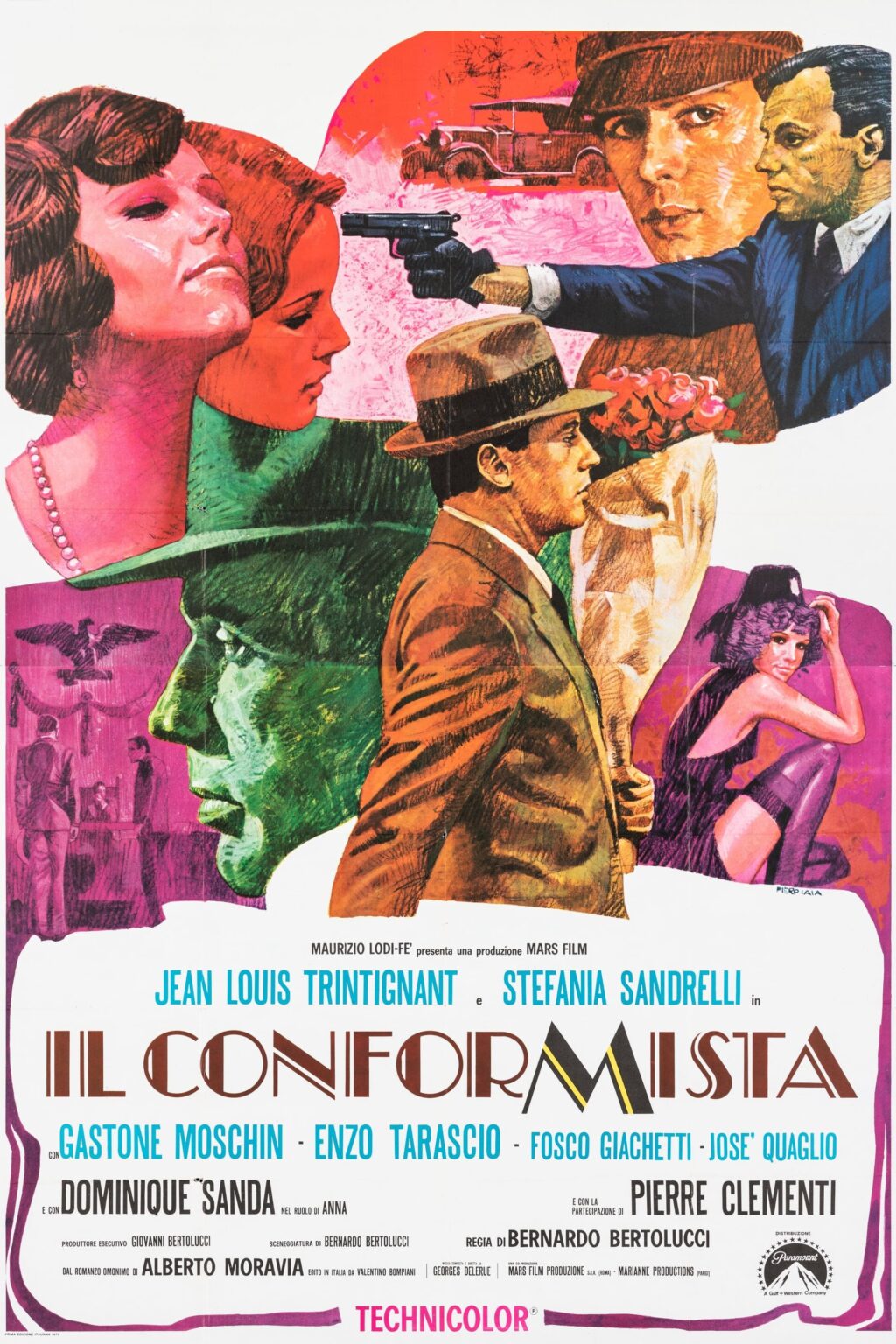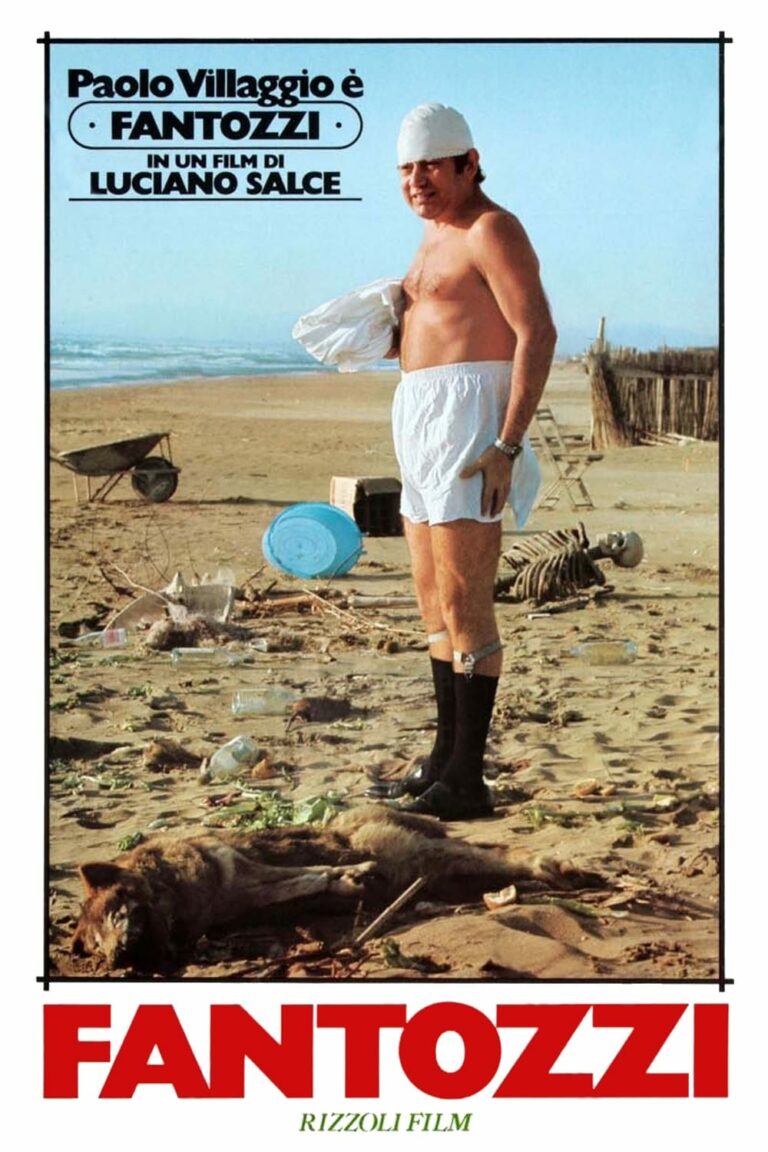
The Conformist (Il conformista), directed by Bernardo Bertolucci in 1970, is a seminal work of Italian cinema that explores themes of conformity, political ideology, and personal guilt. Adapted from Alberto Moravia’s 1951 novel of the same name, the film delves into the psychological complexities of its protagonist, Marcello Clerici, a man willing to suppress his individuality and morality to align with the fascist regime of 1930s Italy. With its striking visual style, layered narrative, and profound thematic depth, The Conformist is celebrated as one of the most influential films in cinematic history.
Introduction
The Conformist is a dazzling exploration of one man’s moral compromise and the societal forces that drive individuals to surrender their autonomy. Bertolucci’s masterful adaptation transforms Moravia’s novel into a visually arresting and intellectually provocative film. By examining the intersection of personal trauma and political allegiance, The Conformist offers a timeless critique of authoritarianism and the human desire to belong.
Plot Summary
Set in Mussolini’s Italy during the 1930s, The Conformist follows Marcello Clerici (Jean-Louis Trintignant), a civil servant haunted by childhood trauma and a desperate need for acceptance.
The Plot Unfolds in Nonlinear Fashion:
- Flashbacks to Marcello’s Childhood:
Marcello’s isolation as a child is marked by an incident with a chauffeur, Lino, who sexually assaults him. In an act of self-defense, Marcello shoots Lino, an event that shapes his psychological need to adhere to societal norms. - The Present (1930s):
As an adult, Marcello seeks to suppress his individuality by marrying Giulia (Stefania Sandrelli), a shallow and conventional woman. Their relationship symbolizes his quest for normalcy. - The Mission:
Marcello is tasked by the fascist government to assassinate his former university professor, Luca Quadri (Enzo Tarascio), now an anti-fascist intellectual living in exile in Paris. - The Climax:
In Paris, Marcello meets Quadri’s enigmatic wife, Anna (Dominique Sanda), with whom he becomes infatuated. The tension culminates in the betrayal and murder of the Quadris, a moment that epitomizes Marcello’s moral collapse. - The Epilogue (Post-War):
After Mussolini’s fall, Marcello turns on his former fascist associates, revealing his opportunistic nature. The film ends with Marcello encountering Lino, whom he presumed dead, symbolizing the unresolved trauma that defines his existence.
Historical Context
Set against the backdrop of fascist Italy, The Conformist reflects the pervasive fear and submission that defined the era. Bertolucci critiques the psychological mechanisms of authoritarian regimes, illustrating how individuals sacrifice morality for security and acceptance. The film’s release in 1970 coincided with a period of political unrest in Italy, making its themes of complicity and resistance particularly resonant.
Bernardo Bertolucci’s Vision
Bertolucci envisioned The Conformist as both a political and personal film. Drawing on Freudian psychoanalysis and Marxist theory, he explores how personal insecurities and societal pressures intertwine. Bertolucci’s use of nonlinear storytelling and visual symbolism reflects Marcello’s fragmented psyche, immersing the audience in his internal conflict.
Main Characters
- Marcello Clerici (Jean-Louis Trintignant):
A morally ambiguous protagonist, Marcello’s conformity stems from deep-seated guilt and fear. His character embodies the dangers of passivity and moral compromise. - Giulia (Stefania Sandrelli):
Marcello’s conventional wife, whose superficiality contrasts with his internal turmoil. - Anna Quadri (Dominique Sanda):
The charismatic and sexually liberated wife of Marcello’s target, Anna represents both temptation and moral ambiguity. - Professor Luca Quadri (Enzo Tarascio):
An intellectual and anti-fascist, Quadri serves as a moral foil to Marcello’s cowardice. - Lino (Pierre Clémenti):
The chauffeur whose assault on young Marcello serves as the catalyst for his psychological conformity.
Themes in The Conformist
1. Conformity and Moral Compromise
The film examines how societal and political pressures lead individuals to betray their principles. Marcello’s desire to conform ultimately makes him complicit in atrocities.
2. Power and Submission
Bertolucci critiques the hierarchical structures that perpetuate authoritarianism, illustrating how power dynamics play out on personal and political levels.
3. Trauma and Repression
Marcello’s unresolved childhood trauma drives his quest for normalcy, revealing the psychological roots of his moral cowardice.
4. Sexuality and Control
Sexuality is a recurring motif, reflecting power dynamics and personal vulnerability. Anna’s seduction of Marcello underscores his internal conflict and inability to assert agency.
Visual and Cinematic Style
Bertolucci’s collaboration with cinematographer Vittorio Storaro is a defining feature of The Conformist. The film’s visual style blends Art Deco design with chiaroscuro lighting and dynamic compositions, creating a surreal and haunting atmosphere.
- Symbolic Use of Color:
Storaro employs muted tones to reflect Marcello’s emotional detachment, contrasted with vibrant colors in moments of passion or conflict. - Innovative Camera Work:
Long tracking shots, reflective surfaces, and angled frames mirror Marcello’s psychological fragmentation. - Architectural Motifs:
Fascist-era architecture serves as a metaphor for rigidity and control, underscoring the themes of conformity.
Cultural and Critical Reception
Upon its release, The Conformist was hailed as a masterpiece, earning accolades for its bold storytelling and visual innovation. Critics praised its intellectual depth and its ability to merge personal and political narratives. The film’s influence extends to directors such as Francis Ford Coppola, Martin Scorsese, and Christopher Nolan, who cite its cinematography and narrative techniques as inspirations.
Comparison to Other Political Films
While films like Costa-Gavras’ Z and Pontecorvo’s The Battle of Algiers focus on overt political activism, The Conformist explores the internal psychology of complicity. Its focus on personal trauma and moral ambiguity sets it apart as a deeply introspective work.
FAQs
- What does the title The Conformist signify?
It reflects Marcello’s willingness to conform to societal norms and political ideologies, sacrificing individuality and morality. - Is The Conformist historically accurate?
While the film is fictional, it authentically captures the psychological and societal dynamics of fascist Italy. - Why is The Conformist considered a masterpiece?
Its combination of innovative visuals, layered storytelling, and profound themes makes it a landmark in cinematic history. - How does Bertolucci use symbolism?
Through visual motifs like mirrors, shadows, and architecture, Bertolucci reflects Marcello’s inner conflict and the oppressive structures of society. - What is the significance of Lino’s return?
Lino’s reappearance symbolizes Marcello’s inability to escape his past and the unresolved trauma that defines him.
Conclusion
The Conformist is a tour de force of political and psychological cinema, offering a searing critique of authoritarianism and the human capacity for moral compromise. Bernardo Bertolucci’s masterful direction, coupled with Vittorio Storaro’s groundbreaking cinematography, creates an enduring work that challenges viewers to confront the complexities of power, guilt, and identity. Over five decades since its release, The Conformist continues to captivate and provoke, securing its place as one of the greatest films ever made.





